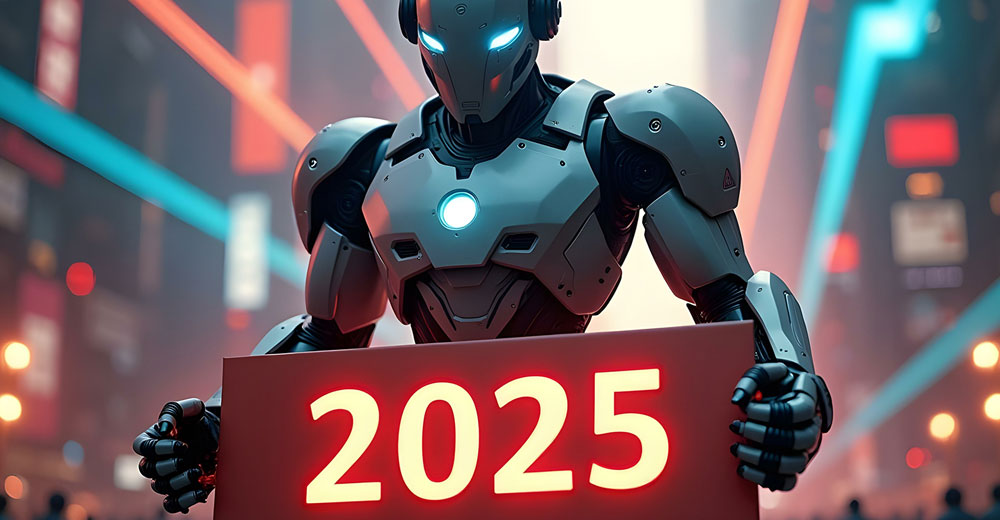The gurus at Gartner released their list of top 10 strategic technology trends to watch in 2025 on Monday — a list heavily influenced by artificial intelligence.
“This year’s top strategic technology trends span AI imperatives and risks, new frontiers of computing and human-machine synergy,” Gartner Vice President Analyst Gene Alvarez said in a statement. “Tracking these trends will help IT leaders shape the future of their organizations with responsible and ethical innovation.”
At the top of the list were Agentic AI systems, which can autonomously plan and execute actions based on user-defined goals. By 2028, the firm predicted that at least 15% of day-to-day work decisions would be made autonomously through Agentic AI, up from 0% in 2024.
“Agentic AI is definitely the future of the enterprise workforce,” said Ambuj Kumar, founder of Simbian, a provider of autonomous AI agents for cybersecurity, in Mountain View, Calif.
“Imagine a field like security where there is a 3.5 million worker shortage, overworked employees, and the need for constant learning about emerging threats,” he told TechNewsWorld. “Against that landscape, how attractive would be an offering that provides virtual employees who are always trained with the latest and greatest, cost 10 times less than humans, work 24×7, and can be scaled elastically based on business demands? That’s the promise of AI Agents.”
Agentic AI Challenges
To obtain the penetration predicted by Gartner, though, Agentic AI technology will have to surmount some challenges. “Designing effective Agentic AI systems is still experimental,” explained Sandi Besen, an applied AI researcher at IBM and Neudesic, a global professional services company.
“As AI engineers and solution architects continue to refine their approaches, the field will evolve,” she told TechNewsWorld.
“Many popular Agentic frameworks approach the design of creating an AI system differently. Currently, popular frameworks like LangChain and Autogen rely heavily on language models to make decisions, while others, like LangGraph, integrate AI agents into more structured, rule-based workflows.
“The success of these systems depends on how they are designed, which is still an evolving area. We will likely see both successes and failures before industry-wide best practices emerge.”
What’s more, she added, “The willingness of businesses to adopt these evolving systems will also be a major factor in the scalability and long-term success of Agentic AI.”
“As AI advances, it has the potential to further improve productivity and provide workers with new ways to solve problems,” said Jennifer Huddleston, a technology policy research fellow at the Cato Institute, a Washington, D.C. think tank.
“There are many different ways this could occur, and some will be industry-specific and quite significant, while others will be more subtle,” she told TechNewsWorld.
“The exact incorporation of AI and the productivity gains from AI will, of course, vary depending on the role and the industry, but it is important policy does not try to predict all the potential uses and allow industry and technology to provide beneficial options to solve a wide range of challenges.”
AI Governance Platforms
Gartner also recommended organizations consider deploying AI governance platforms. Those platforms have the capability to create, manage, and enforce policies for responsible AI use, explain how AI systems work, and provide transparency to build trust and accountability, it explained.
Gartner predicted that by 2028, organizations that implement comprehensive AI governance platforms will experience 40% fewer AI-related ethical incidents compared to those without such systems.
“Without question, AI governance is crucial for mitigating ethical incidents because it provides structured oversight and accountability in AI development and deployment,” said Mark N. Vena, president and principal analyst at SmartTech Research in Las Vegas.
“By implementing clear policies and frameworks, organizations can ensure that AI systems align with ethical standards, such as fairness, transparency, and non-bias,” he told TechNewsWorld.
“Governance platforms also help in monitoring and auditing AI behavior, making it easier to detect and address potential risks early,” he added. “Without proper governance, organizations are more likely to face issues such as discriminatory outcomes, privacy violations, and regulatory non-compliance.”
Addressing Disinformation
Gartner also predicted more organizations will be investing in disinformation security. By 2028, it forecasted that 50% of enterprises will begin adopting products, services or features explicitly designed to address disinformation security use cases, up from less than 5% today.
“Disinformation drives bad decisions, and it is particularly problematic for AIs,” said Rob Enderle, president and principal analyst at the Enderle Group, an advisory services firm in Bend, Ore.
“The AIs will be making decisions on this bad information far more rapidly, making post-decision mitigation nearly impossible by humans,” he told TechNewsWorld. “So solving the disinformation problem becomes even more critical for AIs than it is with humans.”
Vena added that disinformation can harm enterprises by damaging their reputation, as false information spreads quickly and can lead to public distrust.
“It can also result in financial losses if disinformation disrupts operations, influences stock prices, or misguides customers,” he said.
“Additionally,” he continued, “disinformation can create security vulnerabilities by manipulating employees, leading to poor decision-making or increased susceptibility to social engineering attacks.”
Postquantum Cryptography
Postquantum cryptography also needs to be on organizations’ radar in 2025. Quantum computing developments are expected to end several types of conventional cryptography that are now widely used, Gartner explained. It predicted that by 2029, advances in quantum computing will make most conventional asymmetric cryptography unsafe to use.
“I fully agree with Gartner’s statement,” said Florian Neukart, chief product officer at Terra Quantum, a quantum as a service provider in St. Gallen, Switzerland.
“The prediction for 2029 is realistic given the rapid advances in quantum computing,” he told TechNewsWorld.
“Conventional asymmetric cryptography, particularly RSA and ECC, are vulnerable to quantum attacks, such as Shor’s algorithm, which can break these systems. Organizations must start transitioning to post-quantum cryptographic solutions now. Switching cryptographic methods requires significant lead time to ensure sensitive data remains secure in a quantum future.”
Duncan Jones, head of cybersecurity at Quantinuum, an international quantum computing hardware and software company, asserted Gartner’s prediction misses an important point. “What’s important is the date when organizations must take the threat seriously,” he told TechNewsWorld. “And that date has already passed.”
Neuromancer by 2030?
Another strategic technology identified by Gartner is neurological enhancement. It maintains that the tech will have huge potential in three areas: human upskilling, next-generation marketing, and performance. Neurological enhancement will enhance cognitive abilities, enable brands to know what consumers are thinking and feeling, and enhance human neural capabilities to optimize outcomes, it noted.
It predicted that by 2030, 30% of knowledge workers will be enhanced by and dependent on technologies such as bidirectional brain-machine interfaces. Enderle disputed Gartner’s forecast. “Right now, the technology is very limited and requires a level of training for just reading the brain that won’t scale,” he said.
“Feeding information back into the brain hasn’t been sorted yet, at least not publicly,” he explained. “Given the lack of progress here, I think the 2030 prediction is unreliable.”
“However,” he continued, “AI is speeding up a significant amount of development in this area, making it at least possible, if not probable, that this prediction will be accurate.”
“When bidirectional information can flow from and to a brain using these brain-machine interfaces, that will be the true beginning of the Singularity, but given where the technology now is, any timeline would be little more than a slightly educated guess.”
Other strategic technologies in the Gartner spotlight included:
- Greater use of ambient invisible intelligence through ultra-low cost, small smart tags, and sensors will enable a deeper integration of sensing and intelligence into everyday life.
- Growth of energy-efficient computing, with an expectation that by late 2020s, several new compute technologies, such as optical, neuromorphic, and novel accelerators, will emerge for special purpose tasks, such as AI and optimization, which will use significantly less energy.
- Greater use of hybrid computing to create highly efficient transformative innovation environments that perform more effectively than conventional environments.
- Growth of spatial computing to enhance the physical world with augmented and virtual reality, becoming a US$1.7 trillion market by 2033.
- Proliferation of polyfunctional robots — robots that can perform more than one task at a time — so that by 2030, 80% of humans will engage with a smart robot on a daily basis.













